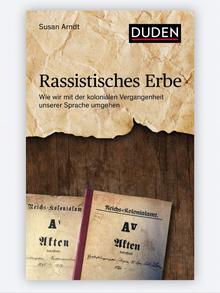
Words can be like small doses of arsenic: they are swallowed imperceptibly, and the poisoning effect only occurs after some time, observed the German philologist and researcher of the language of Nazi Germany, Victor Klemperer, in 1947 in his Notebook. These words are quoted in the preface to Susan Arndt’s new book, The Racist Legacy, which deals with the problem of the colonial past and its influence on modern German.
Arndt wrote his book after years of studying the problem of racism in Germany. “A lot of racist beliefs are expressed in very specific ways through words,” she tells DW. “Of course, if you do without these words, racism won’t go away, but we can better understand this problem by analyzing them.”
Where did racism come from?
Literary scholar and culturologist Arndt sees the roots of racism in 1492, when Queen Isabella I of Castile and her husband Ferdinand V conquered the kingdom of Granada, the last stronghold of Muslim Moors in Spain. “After this conquest, Jews and Muslims were persecuted, their assets confiscated, special taxes were levied on them on the grounds that Christianity is fundamentally superior to other religions,” explains Arndt. The money thus obtained was used to finance the expedition of Christopher Columbus, which discovered the New World.
Columbus was followed by Spanish conquerors and European settlers. As Arndt points out in his book, they were committing genocide in the new territories, while humanist ideals were being propagated in Europe. As this was contrary to European principles, it was necessary to find ways to legitimize something that really lacked legitimacy. To justify colonial practices, the concept of “race” was used, according to which Christians belonged to the highest and most dominant category. People were divided into “races” depending on the color of their skin, and then certain qualities were attributed to them. “It all boiled down to the idea that whites are the only ones capable of progressing, they have reason and culture”, emphasizes Arndt. Proximity to civilization was valued more than proximity to nature. This provided an excuse for Europeans to “colonize nature and colonize the people who lived in it,” explains Arndt.
Back in Spain, Columbus brought several Indians, as he thought, from India.
This concept was later used to justify the enslavement of Africans. In the late 19th – early 20th century, it also formed the basis of the pseudoscientific theory of social Darwinism, which assumed survival of the fittest in sociology, economics, and politics. During the period of National Socialism, another pseudoscience was promoted – eugenics, or racial hygiene, which suggested that “race” could be further optimized. In addition to six million Jews, the Nazis systematically and massively exterminated people with disabilities, homosexuals, Sinti and Roma, and other victims labeled “racially inferior”.
After World War II, racial theories were rarely used, as the book’s author notes, but it is clear that racism has not disappeared. And while principles of equality were promoted, “the global political and financial balance of power, which colonialism promoted for centuries, was not significantly affected,” writes Arndt.
Ways of dealing with racism in language
As neither discourses nor moral values are possible without language, it is important to fight linguistic discrimination, emphasizes the culturologist. In Germany, political correctness gets a lot of attention – last year the Berlin theater even canceled showings of The Nutcracker because of it. And to avoid the racist designation of a person of dark skin color, the Germans abandoned some concepts, for example, “walk in black”, that is, like a hare, or used new terms, in particular, in the media there. is an “N-word” (“N-Wort”).

Susan Arndt book cover
But for racist language to be less and less in everyday life, people must consciously decide which words to leave in their active store. It is important to learn to recognize it. To do this, Arndt suggests asking yourself the following questions. When did the expression come from colonial times and did it change its original meaning? Does this expression mean that there are “human races”, that the person addressed is “close to nature” and “far from civilization”? Does this expression go back to colonial clichés like “half-naked man with feathers”? In what context is the term used and excludes people from the “white norm”?
Arndt gives examples of German such as “Indians”, “Bushmen”, “Eskimos”, as well as other inappropriate terms with racist connotations such as “diaspora”, “people of color” or BIPoC (short for people of non-white race). skin color). The culturologist defends the identification of such expressions in everyday language, but not their prohibition: “I don’t believe in language prohibitions. them and do not change the images they have absorbed. This will not lead to a change in power relations in the end.” The author of the book stresses the importance of people not being ashamed to talk about racist words and terms so that there is more understanding in society and, ideally, they move away from their use. .
Source: DW
Robert is an experienced journalist who has been covering the automobile industry for over a decade. He has a deep understanding of the latest technologies and trends in the industry and is known for his thorough and in-depth reporting.